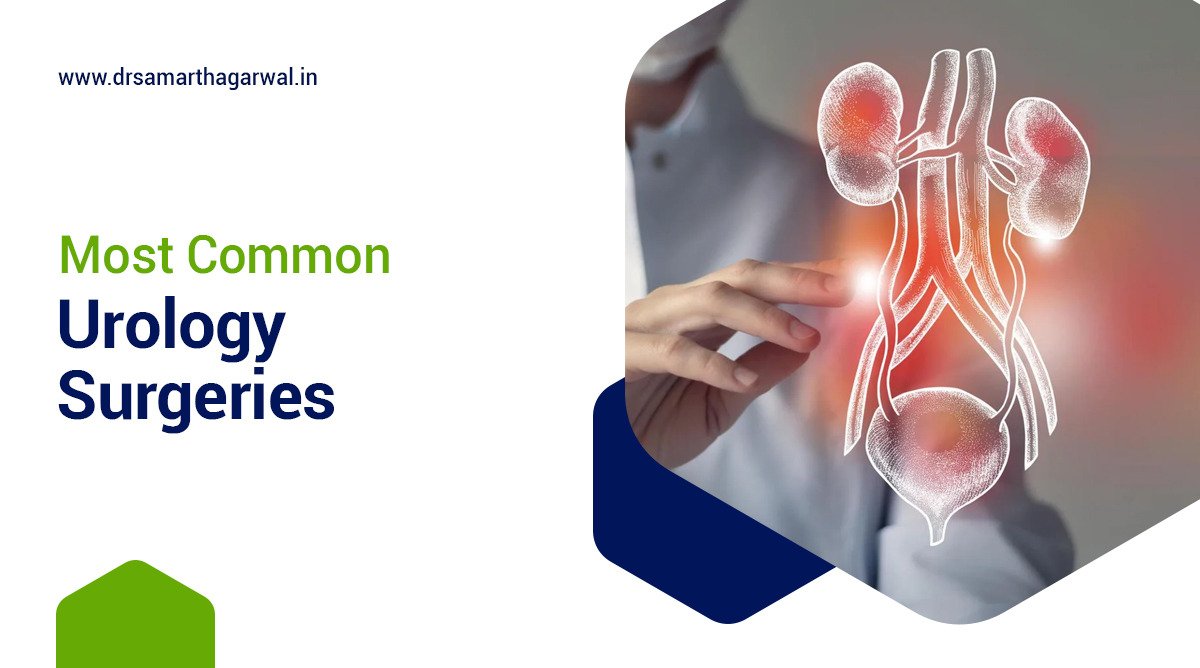Urology, a branch of medicine concerned with the urinary system’s disorders and the male reproductive organs, involves various procedures and surgeries to diagnose and treat these conditions. From addressing kidney stones to treating benign prostatic hyperplasia (BPH), urologists employ both traditional and minimally invasive techniques to provide optimal care. These procedures, essential for maintaining urinary and reproductive health, encompass a wide range of treatments aimed at improving patients’ quality of life. This article will delve into the most common urology procedures and surgeries, highlighting the advancements in minimally invasive techniques that have revolutionized urological care.
12 Common Urology Procedures
1. Vasectomy
A vasectomy is a surgical procedure where the vas deferens, the thin tube that carries sperm from the testicles, is cut and sealed. This outpatient procedure is a popular form of permanent male contraception, preventing sperm from reaching the semen and leaving the body. The simplicity of the procedure, combined with its high efficacy rate, has made vasectomies a favored choice for many men. The minimally invasive nature of this surgery means that it can often be performed in a urology specialist’s office, making it a convenient option for those looking to prevent future pregnancies.
Despite its popularity, some men may reconsider their decision and opt for a vasectomy reversal. This procedure is more complex than the original vasectomy and involves reattaching the severed ends of the vas deferens to allow sperm to enter the semen again. While successful, it requires advanced microscopic surgery techniques and may not guarantee the return of fertility. Therefore, men are advised to thoroughly consider the permanency of a vasectomy before undergoing the procedure.
2. Vasectomy Reversal
Vasectomy reversal is a surgical technique aimed at restoring fertility in men who have undergone a vasectomy. This procedure reconnects the vas deferens, allowing sperm to mix with semen and enable pregnancy. The success rate of vasectomy reversal depends on the time lapse since the original vasectomy; the shorter the time, the higher the chances of successful pregnancy. Urologists specializing in male fertility can perform this complex surgery, typically under general anesthesia. Despite being more intricate than a vasectomy, many men opt for reversal to conceive naturally.
The process of reversing a vasectomy involves careful reconnection of the vas deferens using microscopic surgical methods. This requires the urologist to have considerable skill and experience in the field of reproductive urology. Post-surgery, patients are advised to rest and follow specific guidelines to ensure the best outcome. It’s essential for men to consult with their urology specialist extensively, discussing success rates and potential complications before proceeding with a vasectomy reversal.
3. Cystoscopy
Cystoscopy is a diagnostic tool employed by urologists to examine the bladder and urethra. It involves inserting a cystoscope—a thin, flexible tube equipped with a camera—through the urethra into the bladder. This allows the urologist to visually inspect these areas for any abnormalities, such as tumors, stones, or infections. Cystoscopy can be performed as an outpatient procedure and is crucial for accurately diagnosing various urinary system issues.
The procedure is relatively quick and, while it may cause some discomfort, is generally well-tolerated by patients. In some cases, cystoscopy can also be used for minor treatments, such as removing small bladder stones or taking tissue samples for biopsy. The versatility and minimal invasiveness of cystoscopy make it an invaluable tool in urological diagnostic practices. Patients requiring this procedure may request an appointment with a urology associate who can further explain the process and its benefits.
4. Prostate Procedures
Prostate procedures are common urology procedures focused on treating various prostate conditions, including benign prostatic hyperplasia (BPH) and prostate cancer. Transurethral resection of the prostate (TURP) is a widely used procedure to relieve symptoms of BPH by removing excess prostate tissue obstructing the urethra. This minimally invasive urological surgery involves using a resectoscope inserted through the urethra, eliminating the need for external incisions. TURP has been a gold standard for BPH treatment, offering significant relief from urinary symptoms.
For men with prostate cancer, a prostate biopsy may be performed to diagnose and evaluate the extent of cancer. This involves the use of a fine needle to extract small samples of prostate tissue for laboratory analysis. Advances in urologic diagnostic techniques have improved the precision of prostate biopsies, reducing discomfort and potential complications. Furthermore, minimally invasive robotic surgery has become increasingly prevalent in treating localized prostate cancer, offering patients faster recovery times and reduced risk of side effects.
5. Ureteroscopy
Ureteroscopy is a minimally invasive procedure used to diagnose and treat kidney stones and tumors in the ureter. A ureteroscope—a thin, flexible device—is passed through the urethra and bladder into the ureter. Urologists can then visually inspect the urinary tract, employ laser technology to fragment kidney stones, or even remove small stones without making any incisions. Ureteroscopy has become a preferred method for treating kidney stones, especially those located within the ureter, due to its effectiveness and minimal recovery time.
This procedure offers a high success rate in removing kidney stones and alleviating symptoms. Patients typically undergo ureteroscopy under general anesthesia and can often return home the same day, making it an optimal choice for those seeking a swift resolution to their urologic condition. Post-operative care is generally straightforward, with most individuals resuming normal activities shortly after. Ureteroscopy highlights the advancements in minimally invasive urological surgery, promoting faster healing and reducing the risks associated with open surgery.
6. Lithotripsy
Lithotripsy is a non-invasive procedure utilized to shatter kidney stones into smaller, passable pieces using shockwaves. This technique allows patients to avoid surgery, offering a convenient and effective treatment option for kidney stones. During the procedure, focused ultrasonic waves or shockwaves are directed at the stone, breaking it into pieces small enough to be passed through the urinary tract. Lithotripsy has gained popularity for its ability to treat kidney stones without the need for an incision or hospital stay, enabling patients to resume their daily activities quickly.
While lithotripsy is highly effective for stones less than 2 centimeters in diameter, larger stones may require additional treatments or alternative surgical procedures. The process is usually performed on an outpatient basis, and though it may cause some discomfort, pain management options are available to ensure patient comfort. The ease and efficacy of lithotripsy exemplify the advancements in minimally invasive urological treatments, making it a first-line therapy for many individuals suffering from kidney stones.
7. Orchiopexy
Orchiopexy is a surgical procedure performed to correct undescended testicles, a condition commonly referred to as cryptorchidism. This condition affects newborn males when one or both testicles fail to descend into the scrotum before birth. Orchiopexy involves surgically moving the undescended testicle(s) into the scrotum and securing them in place. This procedure is generally recommended to be performed during early childhood to prevent potential complications such as infertility or increased risk of testicular cancer. As an essential urologic condition treatment, orchiopexy reflects the importance of timely intervention in pediatric urology.
The surgery is typically performed under general anesthesia, with most patients returning home the same day. Post-operative care includes limited physical activity and regular follow-up appointments to ensure the testicles remain in the proper position. The success rate of orchiopexy is high, offering favorable long-term outcomes for affected children. By addressing cryptorchidism early, urologists play a crucial role in preserving future fertility and reducing the risk of other health issues associated with undescended testicles.
8. Penile Plication
Penile plication is a surgical procedure designed to correct penile curvature, a condition often resulting from Peyronie’s disease. The surgery involves shortening the longer side of the penis with sutures to straighten its overall structure. This approach helps restore a more natural appearance and function to the penis, improving sexual health and performance. Penile plication offers a less invasive alternative to more complex reconstructive surgeries, with most men experiencing satisfactory outcomes.
The benefit of penile plication lies in its simplicity and effectiveness, providing relief to men suffering from discomfort or erectile dysfunction due to penile curvature. The procedure typically requires only a brief hospital stay and has a relatively short recovery period. Men considering penile plication are advised to discuss their expectations and potential outcomes with their urologist, ensuring a comprehensive understanding of the procedure’s benefits and limitations. The success of penile plication in alleviating penile curvature symbolizes the progress in treating urological conditions affecting men’s sexual health.
9. Penile Implants & Prosthesis
Penile implants and prostheses represent advanced surgical options for men with severe erectile dysfunction (ED) unresponsive to conventional treatments. These devices are surgically inserted into the penis to provide rigidity and support, enabling satisfactory sexual intercourse. Penile implants come in two main types: inflatable and malleable. Inflatable implants allow for the control of erection timing and firmness, while malleable implants provide a permanently firm penis that can be positioned as desired. The decision between the two types depends on patient and surgeon preference, considering factors such as ease of use and natural appearance.
The procedure to implant these devices is considered a last resort for treating ED and is usually recommended after less invasive options have been exhausted. Recovery from penile implant surgery involves a period of healing and adjustment, with most men returning to sexual activity within a few months. Despite the invasiveness of the procedure, patient satisfaction rates are high, with many men reporting improved sexual function and quality of life. Penile implants underscore the breadth of urological surgery’s capabilities in restoring sexual health and confidence to men with ED.
10. Male circumcision
Male circumcision is a common urological procedure involving the surgical removal of the foreskin from the penis. Traditionally performed for religious or cultural reasons, circumcision is also recognized for its health benefits, including a reduced risk of urinary tract infections, certain sexually transmitted infections, and penile cancer. This procedure can be performed at any age, though it is most commonly done in newborns. Circumcision is usually an outpatient procedure, with recovery typically involving minimal discomfort.
While the decision to perform circumcision is often influenced by personal, cultural, or religious factors, medical considerations also play a vital role. The American Urological Association acknowledges the benefits of circumcision while recommending that the decision be made by parents or the patient, considering medical information and personal beliefs. The procedure is safely performed by trained professionals and has a low complication rate, making it a widely accepted practice in urology. Circumcision exemplifies a procedure with both traditional significance and modern medical relevance, showcasing the diversity of treatments within the field of urology.
11. UroLift
The UroLift system is a revolutionary minimally invasive treatment for benign prostatic hyperplasia (BPH), providing an alternative to traditional surgical procedures like TURP. It involves placing tiny implants that lift and hold the enlarged prostate tissue away from the urethra, thereby relieving urinary obstruction without cutting, heating, or removing prostate tissue. This unique approach allows for a quicker recovery time compared to conventional prostate surgeries and has been shown to effectively improve urinary symptoms due to BPH.
UroLift’s minimally invasive nature translates into significant benefits for patients, including reduced risk of sexual dysfunction and the possibility of returning to daily activities shortly after the procedure. It’s particularly appealing to men seeking a solution to BPH symptoms without the potential complications associated with more invasive surgeries. As advancements in urology continue, procedures like UroLift represent the field’s move towards innovative treatments that prioritize patient quality of life and recovery.
12. Transurethral incision of the prostate (TUIP)
Transurethral incision of the prostate (TUIP) is another surgical option for men with benign prostatic hyperplasia. Unlike TURP, TUIP involves making one or two small incisions in the prostate to relieve pressure on the urethra, without removing significant amounts of prostate tissue. This procedure is often recommended for men with smaller prostate enlargements. TUIP is less invasive than TURP, resulting in a potentially shorter hospital stay and quicker recovery.
The effectiveness of TUIP in improving urinary flow with fewer side effects has made it a preferred option for certain patients. As it preserves more of the prostate tissue, the risk of sexual dysfunction post-operation is considered lower compared to more extensive prostate surgeries. TUIP exemplifies the advancements in surgical techniques that offer patients options with varying degrees of invasiveness, catering to individual needs and conditions. The ongoing development of such procedures underscores the dynamic nature of urology, constantly evolving to improve patient care and outcomes.
You might be interested in this: Overactive Bladder Therapy Options
What are some different Procedures related to Urology
Prostate Procedures
Prostate procedures in urology encompass various diagnostic and treatment interventions aimed at addressing conditions such as benign prostatic hyperplasia (BPH) and prostate cancer. Common procedures include transurethral resection of the prostate (TURP), prostate biopsy, UroLift, transurethral needle ablation (TUNA), and prostate laser surgery. TURP, for instance, involves the removal of prostate tissue through the urethra using a resectoscope and is typically done under anesthesia. It’s crucial to discuss the potential outcomes, risks, and recovery with a urologist before undergoing any procedure to ensure personalized care and optimal results.
Kidney Procedures
Kidney procedures in urology encompass a variety of interventions, ranging from lithotripsy for kidney stones to nephrectomy for kidney cancer, often performed laparoscopically for quicker recovery. Common procedures include percutaneous nephrolithotomy (PCNL) for large stones, laparoscopic cyst ablation for cysts, and laparoscopic pyeloplasty for ureter-kidney issues. Additionally, treatments such as extracorporeal shock wave lithotripsy (ESWL) and nephrectomy with vein involvement are available, tailored to the severity and nature of the kidney condition. For comprehensive care, consultation with a urology specialist is recommended to explore suitable procedures aligned with individual health needs.
Bladder Procedures
Bladder Procedures in Urology encompass various diagnostic and therapeutic interventions aimed at addressing bladder-related conditions. These procedures include cystoscopy, which allows for a detailed examination of the bladder and urethra using a specialized instrument equipped with a camera and light.
Additionally, treatments like lithotripsy utilize shock waves or lasers to break down stones within the bladder, kidney, or ureter, facilitating their passage through the urinary system. Other procedures such as orchiopexy are performed to repair conditions like undescended testicles. The scope of urologic procedures extends to encompass diverse techniques, from minimally invasive surgeries like robotic procedures to traditional interventions such as cystectomy for bladder cancer.
Collaboration between urologists and multidisciplinary teams is crucial in diagnosing and managing complex bladder conditions effectively, emphasizing a holistic approach to patient care. Specialized technologies like blue light cystoscopy aid in the detection and diagnosis of bladder tumors, enhancing diagnostic accuracy and treatment outcomes. Overall, urology procedures play a pivotal role in diagnosing, treating, and managing a wide range of bladder-related issues, contributing to improved patient health and well-being.
Penis, Scrotal & Infertility
Penis, scrotal, and infertility procedures in urology encompass a range of treatments including vasectomy, vasectomy reversal, hydrocelectomy, varicocelectomy, orchiectomy, penectomy, inflatable penile implant, testicular sperm extraction (TESE), microsurgical epididymal sperm aspiration (MESA), and circumcision, among others.
These procedures are performed to address conditions such as male infertility, hydrocele, varicocele, undescended testis, sperm production or delivery issues, and scrotal reconstruction following trauma or other medical interventions. Utilizing office-based andrology procedures under local anesthesia has emerged as a cost-effective and patient-preferred alternative, offering reduced healthcare costs and comparable outcomes compared to traditional operating room settings (Alom et al., 2017). Technical considerations for scrotal reconstruction involve skin grafting techniques such as split-thickness or full-thickness skin grafts, with outcomes relatively similar across approaches (Lucas et al., 2017). Additional treatments like penile plication address conditions like Peyronie’s disease, aiming to correct penile curvature for improved function. Scrotal ultrasound and semen analysis are diagnostic tools used in the evaluation of male infertility, helping to identify potential causes such as sperm abnormalities, testicular issues, or blockages in sperm delivery (Mayo Clinic, Cleveland Clinic). Overall, a comprehensive approach to addressing penis, scrotal, and infertility issues in urology involves a combination of diagnostic assessments, surgical interventions, and post-operative care tailored to individual patient needs.

Contact Dr. Samarth Agarwal if you have any questions or concerns about your Urinary health!
What do urological surgeons do?
Urological surgeons, also known as urologists, are specialized physicians trained to diagnose and treat disorders of the urinary system in both men and women, as well as the male reproductive system. They possess expertise in a wide range of conditions, including kidney stones, urinary tract infections, bladder disorders, prostate conditions, and male infertility. Urologists utilize both surgical and non-surgical means to address these issues, with a focus on minimally invasive techniques to reduce patient recovery time and discomfort.
From conducting prostate biopsies to performing complex surgeries like penile implants and TURP, urologists are at the forefront of medical advancements in their field. They are adept at employing state-of-the-art technologies, including robotic surgery, to enhance precision and outcomes in urological care. Additionally, urologists play a key role in preventative care, offering advice and treatment options to maintain urinary health and prevent future complications. Their comprehensive training and dedication to patient care make urologists invaluable in diagnosing and treating urologic conditions, improving patients’ quality of life.





